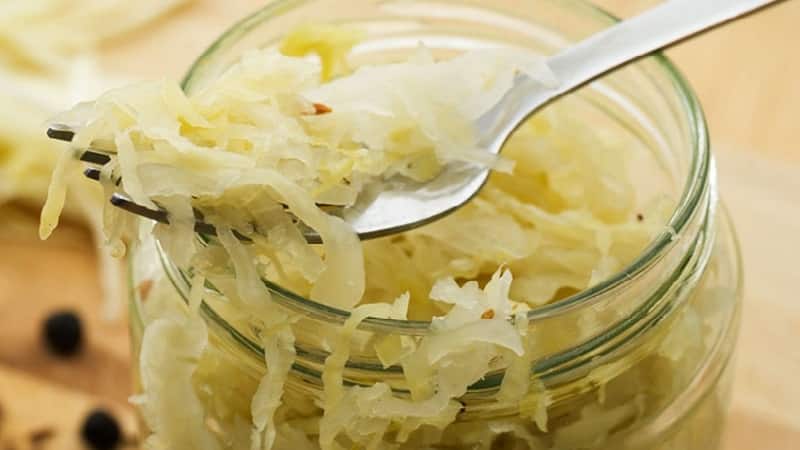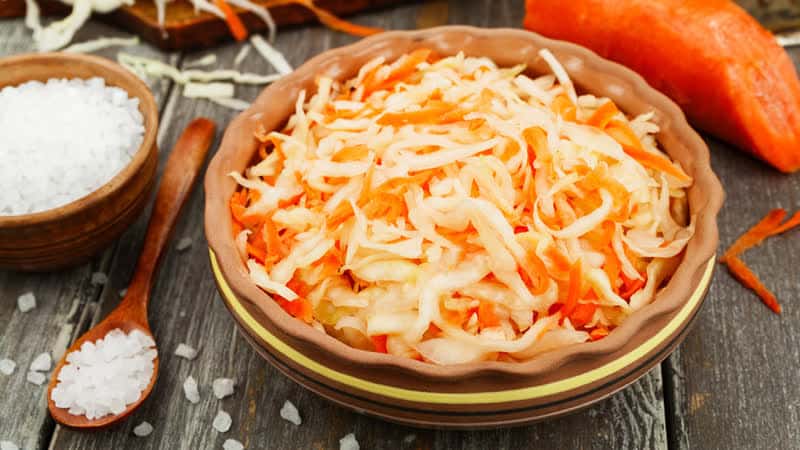The most common mistakes when sauerkraut: what can be done to avoid them
The classic recipe for sauerkraut is simple and does not require special skills. But even experienced housewives sometimes have incidents: the product darkens, acquires an unpleasant odor and is slimy. This indicates a violation of the cooking technology, since fermentation is a complex chemical process. What errors lead to failure and how to avoid disastrous results - read on.
What happens if you don’t add enough salt to the cabbage when fermenting?
Fermentation occurs as a result of lactic acid fermentation. Lactobacilli convert the sugar contained in vegetables into lactic acid, which activates vitamins and prevents the proliferation of putrefactive bacteria. To start this chemical reaction salt - not a required ingredient. There are recipes for salt-free sauerkraut, but this dish takes some getting used to.
Attention. When added to chopped vegetables, salt acts as a catalyst in the fermentation reaction. It causes plasmolysis of cells and promotes increased secretion of juice - a brine is formed in which lactobacilli and other microorganisms multiply. In salt-free recipes, the role of a nutrient solution is played by water added to the workpiece.
 If the technology is followed, on the second day the brine should completely cover the vegetables. As it evaporates, the number of bacteria increases.The remaining salt and lactic acid produced by lactobacilli inhibit the growth of other pathogenic microorganisms - as a result, the product does not rot, but is preserved.
If the technology is followed, on the second day the brine should completely cover the vegetables. As it evaporates, the number of bacteria increases.The remaining salt and lactic acid produced by lactobacilli inhibit the growth of other pathogenic microorganisms - as a result, the product does not rot, but is preserved.
Important. If there is a lack of salt, little brine is formed - the cabbage left without it will dry out or go rotten.
Is it possible to add salt later?
The workpiece is added with salt before the fermentation process begins, that is, until foam and bubbles appear. Salt added later blocks the growth of lactobacilli. Eventually cabbage does not ferment.
Add salt in one of two ways:
- add salt and mix thoroughly;
- add ready-made brine at room temperature: 1 tbsp per 1 liter of water. l. salt and sugar.
If you add salt too late, increase the pressure so that more juice is released. Or they use this cabbage for first and second courses, and ferment a new batch for salads.
The most common mistakes when sauerkraut and their consequences
Under-salting is one of the reasons why a dish fails. Other common mistakes also lead to sad results.
Choose a variety of cabbage that is not suitable for pickling
To start the fermentation process, polysaccharides are needed. There are not enough of them in young cabbage and in heads of late varieties. And often such preparations do not ferment, but dry out or rot.
Reference. Late varieties of cabbage accumulate polysaccharides during storage, so they are taken for pickling no earlier than December.
Do not use oppression or choose light oppression
The pressure is applied so that the cabbage releases more juice for the brine. Its other purpose is to reduce the amount of air in which harmful bacteria live. Without pressure, the product may deteriorate.
Cannot withstand temperature and fermentation time

Fermentation takes place in three stages:
- Reproduction of lactobacilli: at temperatures from +17°C to +24°C for 2-3 days. The brine becomes cloudy, foam and gas bubbles appear on the surface.
- Formation of lactic acid: 5-7 days at temperatures up to +20°C. It inhibits the growth of microorganisms, and after fermentation is complete, no gases are released from the cabbage.
- Post-fermentation: in the refrigerator for several months. In a warm place, mold grows and the dish spoils.
Due to overexposure at the first stage, transparent mucus forms in the cabbage - the result of the proliferation of lactobacilli.
Important. Exceeding the temperature during the fermentation stage leads to the growth of harmful bacteria and fungi. The cabbage darkens and becomes inedible.
If the product is put into the refrigerator before fermentation is complete, it will have an unpleasant odor of lactic acid.
Using utensils that are not suitable for fermentation
Lactic acid reacts chemically with metal dishes. The resulting oxide causes the cabbage to darken.
Do not release gases from the product during fermentation
Gases are the result of active reproduction of bacteria. Because of them, cabbage acquires a bitter taste.
Iodized salt is used
Iodine is an active chemical element - under its influence, cabbage darkens and softens.
How to understand that something went wrong - signs of improper preparation

You can tell if the preparation was a success by its appearance and taste.
What cabbage shouldn't look like
The finished product has a white or pale yellow color, a firm crisp texture and a spicy cabbage smell. The taste is sweet and sour, without bitterness.
The cabbage didn't work out:
- if it has darkened;
- mucus appeared in it;
- she's soft and soggy or, on the contrary, dry;
- there is a foreign smell.
How to find out why the cabbage didn't turn out
| Product problem | Possible reasons |
| 1. Dark yellow color | Colored by carrots. |
| 2. Red color | If the temperature was exceeded during the fermentation stage or there was not enough pressure, mold fungi have appeared. |
| 3. Darkened | 3.1. Stained by oxide from metal utensils.
3.2. Iodized salt was used. 3.3. If the temperature was exceeded during the fermentation stage, or there was not enough oppression weight, harmful bacteria appeared. 3.4. They didn't add enough salt. |
| 4. Slime | 4. Overexposed during the growth stage of lactobacilli. |
| 5. Not crunchy, soft | 5.1. They did not add enough salt or used iodized salt.
5.2. Left it at the fermentation stage. |
| 6. Sour taste | 6.1. They didn't add enough salt.
6.2. Left it at the fermentation stage. |
| 7. Bitter taste | 7. Gases were not released from the product during fermentation. |
| 8. Bad smell | 8.1. Didn't keep it at the fermentation stage.
8.2. If the temperature is exceeded, pathogenic microorganisms appear. 8.3. The smell from the dishes was absorbed. |
Is it possible to eat “snotty”, dark or bad-smelling cabbage?
Darkened, “snotty” or bad-smelling cabbage looks unappetizing, but is suitable for eating in the following cases:
- mucus is clear;
- the product has darkened due to dishes, carrots, under-salting or the use of iodized salt;
- the smell came from the dishes.
This cabbage can be used as an ingredient for first and second courses.
In other situations, the product is spoiled and it is dangerous to eat it.
Cooking tips and tricks

A few tips from experienced housewives:
- For pickling, choose white, not too dense heads of cabbage, collected in September - October. Only white leaves are used and green leaves are removed.
- Do not wash cabbage before shredding.
- For fermentation, use clean glass or enamel dishes. Metal will make the product darker, while wood will turn gray.
- The carrots are cut finely, rather than grated, so that excess juice does not color the cabbage.
- Table salt is used, not iodized salt, at the rate of 25-30 g per 1 kg of product.
- During the shredding process, the cabbage is crushed by hand and placed tightly in a pickling bowl - this will release more juice.
- From the first day after fermentation, the level of brine is monitored so that there is enough of it. If there is a lack of liquid, remove the vegetables without brine or use more weight.
- The oppression is not removed until the end of the fermentation process. Metal objects are not used as oppression.
- Starting from the second day, the product is periodically pierced with a wooden stick to the bottom of the dish to release gases.
- During the fermentation process, remove excess foam or place the dishes with the preparation in a wide basin where the foam will drain.
- Monitor the required temperature during the fermentation stage.
- The product is ready when foam stops releasing - approximately 5-7 days. Prepared cabbage is stored in the refrigerator.
Conclusion
To make sauerkraut spicy, juicy and crispy, it is important Right choose products, dishes, pressure and monitor compliance with technology at all stages of preparation. Inattention to detail costs the taste of the product. The tips from the article will help you avoid mistakes when preparing this wonderful dish.